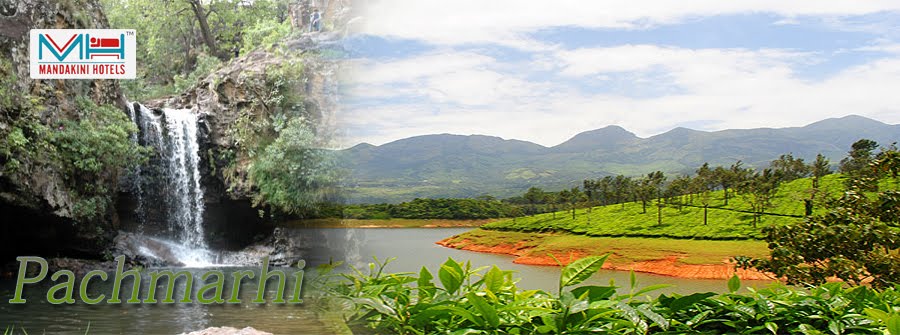Verdant Jewel of the Hills
Pachmarhi is Madhya Pradesh's most verdant jewel, a place where nature has found exquisite expression in myriad enchanting ways. Green shades embrace the mountains, and everywhere is heard the gentle murmur of flowing water. Bridle paths lead into tranquil forest glades, groves of wild bamboo and jamun, dense sal forests and delicate bamboo thickets.
Complementing the magnificence of nature are the works of man; Pachmarhi is also an archaeological treasure-house. In cave shelters in the Mahadeo Hills is an astonishing richness in rock paintings. Most of these have been placed in the period 500-800 AD, but the earliest paintings are an estimated 10,000 years old.
The year was 1857 when Captain James Forsyth of the Bengal Lancers was galloping hard up the Satpura ranges. He chanced upon this saucer -shaped valley and recommended its development as a sanatorium. Churches and cemetries bring back memories of the colonial past of Pachmarhi which has managed to escape reckless plunder suffered by other hill stations of India
Places to visit
Catholic Church
Built in 1892 by the British, the Catholic Church is a blend of French and Irish architecture. Its Belgium stained-glass win-dows add rare attraction and beauty to the building. The Church has a cemetery attached to it and graves date from 1859, World War I and II.
Christ Church
Build in 1875 by the British, this church is generally regarded as the most beautiful small church in Madhya Pradesh. The Church's architecture is fascinating; its 'sanctum-sanctorum' has a hemispherical dome on top with its ribs ending with faces of angels. The stained-glass panes adoring the walls and rear of the altar were imported from Europe. They present a gorgeous view as sun rays pass.
Priyadarshini Point
This vantage viewing point marks the place from where Pachmarhi was discovered. In 1857 Tis Capfrain Forsyth a Bengal Lancer , Approached the plateau at the head of a column of troops. At this point (originally name' after him), he first glimpsed the extraordinary beauty of this aucer-shaped scenic spot. Acting on Forsyth's information the British developed Pachmarhi as a sanatorium and his resort and even today, their legacy remains, embodied Pachmarhi's church and colonial architecture.
Apsara Vibaii
A lovely little bathing pool, and easily accessible from Jai Stambh, this 'fairy pool' is an idea. Picnic spot for families with children, as the pool is shallow. Deepening only towards the base of the fall which cascade gently into its waters.
Rajat Pratap
Those seeking adventure will find it in this ten-minute walk over rocks and boulders from Apsara Vihar to the top of Rajat Pratap, the 'big fall'. A thrilling experience is looking straight down to the bottom of the fall which plunges down a 350-foot-high precipice.
Raj Giri : Also known as Club Hill, this is a short, easy climb from Pachmarhi Club to a 300-feet-high spot from where you get a panoramic view of Pachmarhi.
Jalawataran (Duchess Fall)
3 km along the path fromBelle View, branching off from the milestone for Bhrant Neer, is a route to the beautiful Duchess Fall. The descent is steep and the trek a strenuous one for almost all of the 4 km walk to the base of the first cascade of the fall. This waterfall, which tumbles down in three distinct cascades, is the most picturesque of all Pachmarhi's falls.
Lanjee Giri
This hill can be scaled from both east and west. For the rock-climbing enthusiast, there are some easy scalings to be done near the summit. Near the western summit is an underground passage leading down the northern face.
Sunder Kund (Saunder's Pool)
Crossing the stream below Duchess Fall and following a footpath about 2.5 km in a south-west direction, brings one to a huge rocky pool in the Jambu Dwip stream. This is an excellent place for swimming.
PACHMARHI
Pachmarhi is Madhya Pradesh's most verdant gem. A lovely hill resort girdled by the Satpura ranges, it offers absolute tranquility. Bridle paths lead into placid forest groves of wild bamboo, jamun, dense sal forests and delicate bamboo thickets
Explore:
Complementing the magnificence of nature are the works of man; Pachmarhi is also an archaeological treasure- house. In cave shelters in the Mahadeo Hills is an astonishing richness in rock paintings. Most of these have been placed in the period 500-800 AD, but the earliest paintings are an estimated 10,000 years old.
 In Pachmarhi, Bagpipes skirled in a flower-bright valley while ancient dancers cavorted on a rock. The pipes and the dancers were separated by thousands of years: typical of this little town in the Saptura Mountains. Contrasting cultures and ages exist in harmony as if time and trends mean little in this serene, wooded place. Pachmarhi is for unwinding, effortlessly. Roads meander gently groves of trees, open spaces and heritage cottages sitting contentedly in their old gardens.
In Pachmarhi, Bagpipes skirled in a flower-bright valley while ancient dancers cavorted on a rock. The pipes and the dancers were separated by thousands of years: typical of this little town in the Saptura Mountains. Contrasting cultures and ages exist in harmony as if time and trends mean little in this serene, wooded place. Pachmarhi is for unwinding, effortlessly. Roads meander gently groves of trees, open spaces and heritage cottages sitting contentedly in their old gardens.The town has a quiet gentility about it as if Victorian traditions and high collars still governed most people's lives. Much of this ambience has been set, and is still being maintained, by the strong presence of the Army whose Education Corps is headquartered here. The old cottages, meticulously maintained by the Military Engineering Serivces, have changed little since the days of Kipling.

